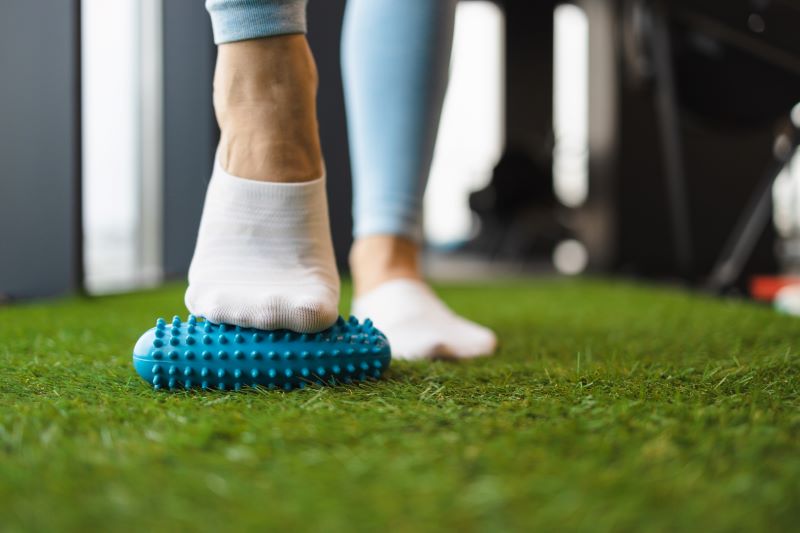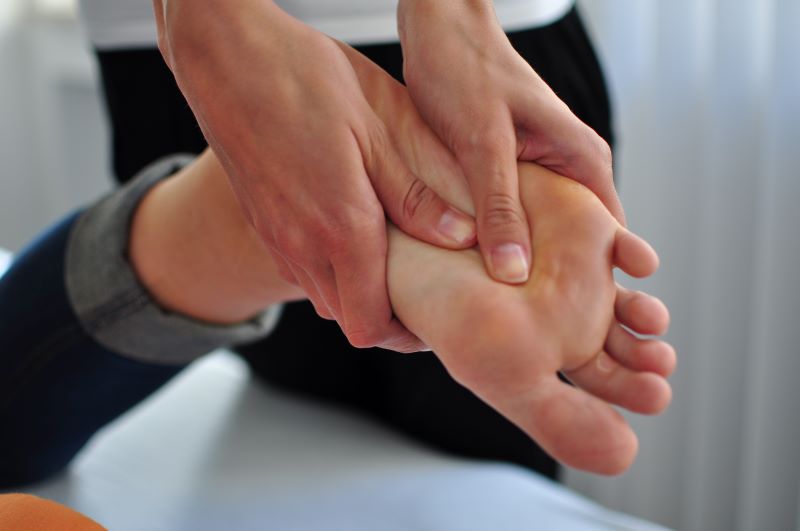It is possible for some people to power through pain in the ball of the foot. But in most cases, foot pain stops an individual in their tracks. Fortunately, there are many forms of treatment for foot pain. These treatments can help reduce or even prevent future pain. Put an end to foot pain by taking these steps to prevent it.

Metatarsalgia
Foot pain is commonly referred to as metatarsalgia, which is the medical term for pain under the ball of the foot. Medical professionals use the umbrella term “metatarsalgia” to describe this type of foot pain since it occurs from a wide variety of potential causes.
Ball of Foot Pain
When we stand and move, we place the most pressure directly below our toes, which is where ball of foot pain occurs. In some cases, flexing the toes may also result in numbness, shooting pain, or immediate pain.
There are several factors that contribute to pain in the ball of the foot, including:
- Certain foot abnormalities that cause incorrect pressure distribution on the ball of the foot. For instance, having a long second toe, flat feet, hammertoes, or high arches.
- High-impact activities such as running, jumping, or standing for long periods of time.
- Symptoms of arthritis or joint inflammation in the feet, such as rheumatoid arthritis or osteoarthritis.
- Not wearing shoes that fit well or provide adequate support.
- High heels that transfer your weight to the front of the foot.
- Being overweight, leading to the uneven distribution of body weight between the metatarsals and the ball of the foot when walking.
- Morton’s neuroma, a painful condition that involves the thickening of fibrous tissue around nerves between the metatarsals on the ball of the foot.
- The tightening of tissues of the foot with the Plantar fasciitis condition.
Remedies for Ball of Foot Pain
Pain in the ball of the foot can be treated as soon as the cause is identified. In order to alleviate the pain and prevent further irritation, there are a few things that can be done to treat pain in the ball of the foot.
- The foot should be rested after activity whenever possible.
- Apply an ice pack every two to the foot because inflammation and swelling may be reduced by applying ice.
- Wear comfortable shoes. It is common for doctors to recommend changing from heels to flats. Shoes should fit properly. A pair of tight shoes can cause the feet to misalign while standing or walking, resulting in an unsteady gait.
- Exercise and do targeted stretches to ease pain and increase strength and flexibility.
- Increased movement and weight management may help relieve strain on the balls of the feet caused by excess weight. Depending on lifestyle and other health complications, a doctor may recommend specific weight management programs.
- Orthotic inserts should be used. Doctors may prescribe orthotic inserts or recommend commercial shoe inserts depending on the severity of the condition. The purpose of orthotic inserts is to help align the foot and provide extra cushioning. There may also be relief from pain when a pad is placed under the ball of the foot.
 The Outlook for Pain in Ball of Foot
The Outlook for Pain in Ball of Foot
With proper treatment and rest, ball of foot pain can usually be treated at home because it doesn’t have a high risk of complications. However, it is best to see a doctor if the pain is severe or lasts longer than a few days for advice on the best course of action.
Keep in mind, walking may be affected by ball of foot pain if left untreated. A limp is sometimes exhibited as bearing weight is avoided on the part of the foot that hurts. When this happens, in addition to foot pain, the lower back and hips can also be affected.
Metatarsalgia Outlook
Metatarsalgia can be debilitating, even though it is generally not considered to be a serious medical issue. Many symptoms of metatarsalgia can also be relieved by at-home treatments. The best remedy for metatarsalgia is to ice and rest the foot. Metatarsalgia may be prevented or minimized by wearing appropriate footwear with shock-absorbing insoles or arch supports.
Plantar Fasciitis Outlook
During rest times, off the feet, the pain may ease, but return once activities are resumed. It is fairly common to have this type of foot pain when experiencing plantar fasciitis. Inflammation of the tendons, ligaments, and cartilage surrounding the metatarsal bones from plantar fasciitis causes pain in the ball of the foot. The pain commonly occurs in people wearing poorly-fitted shoes, who are obese, or with other foot conditions.
Weight Management
While rest can resolve most cases of ball of foot pain. It is also important to focus on maintaining a moderate weight. Be sure and wear comfortable shoes to help prevent ball of foot pain while exercising. Rest the foot as much as possible if the pain is aggravated by physical activity.
Medical Care
Always seek medical advice when experiencing chronic pain. A medical professional will give care directions specific to the cause of pain, which helps speed up recovery. An orthopedic surgeon or podiatrist may recommend corrective surgery if ball of foot pain is caused by hammer toes, pinched nerves, or other complications. However, in most cases, surgery is not needed as less invasive treatments are proven to effectively relieve ball of foot pain.
There are times when the pain in the ball of the foot disappears on its own after a few days. Make an appointment with a doctor if the pain lasts for more than a few days after changing footwear, or if there is swelling or discoloration along with the pain. In order to determine what is causing pain in the ball of the foot, the doctor will examine the foot both standing and sitting. Additionally, they may want to examine how they walk.
In addition, an X-ray may be ordered to detect any stress fractures or muscle tears. Anyone experiencing foot pain should tell the doctor if they have other health issues, such as diabetes. People with diabetes may need immediate attention if they experience ball of foot pain. It is possible that the doctor will also order additional tests to determine whether the patient has gout, arthritis, bursitis, or Morton’s neuroma.
 Foot and Ankle Specialists of Illinois
Foot and Ankle Specialists of Illinois
Only a doctor can diagnose your pain. If you are in the Algonquin area and you are having pains in the ball of your foot, the Foot and Ankle Specialists of Illinois have you covered. Our expert doctors offer comprehensive care from sprains to breaks to bunions and calluses. If the problem is your feet or ankles, we can take care of it and get you up and running.

